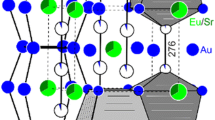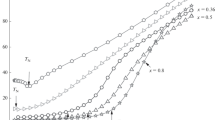Abstract
The electron paramagnetic resonance (EPR) spectra and the stationary magnetic susceptibility are investigated for Ca1–x Eu x S and Sr1–x Eu x S solid solutions (0.00005 < x < 0.0032). The EPR spectrum of Eu2+ in both matrices contains a wide structureless line in addition to the narrow lines of the superfine structure characteristic of ions with high local symmetry. Because of the extraordinary temperature dependence of this line in CaS:Eu, it is associated with strongly interacting magnetic centers, namely, exchange-coupling pairs and chains or more complex clusters of magnetic ions. At the same time, the dependence of the stationary magnetic susceptibility in the temperature range 4.2–50 K has no peculiarities for CaS:Eu and SrS:Eu and obeys the Curie law.
Similar content being viewed by others
REFERENCES
V. Klatt and P. Lenard, Wied. Ann., 38, 90 (1889).
C. Pappas, M. Meissner, G. Schmidt, et al., Physica, B165, Pt. 1, 185–186 (1990).
M.-L. Yu. Allsalu, M. I. Danilkin, V. D. Kuznetsov, et al., Vestn. Mosk. Univ., Ser. 3, Fiz., Astron., 30, No. 2, 97–99 (1989).
M. Pham-Thi, N. Ruelle, E. Tronc, et al., Jpn. J. Appl. Phys., 33, No. 4A, Pt. 1, 1876–1884 (1994).
D. G. Andrianov, N. M. Pavlov, A. S. Savel'ev, et al., Fiz. Tekh. Poluprovodn., 14, No. 6, 1202–1212 (1980).
S. Ozeroff and P. Kizom, Semimagnetic Semiconductors [Russian translation], Mir, Moscow (1992).
A. A. Manenkov and A. M. Prokhorov, Dokl. Akad. Nauk SSSR, 107, No. 3, 402–404 (1956).
M. Danilkin, M. Must, É. Pedak, et al., Zh. Prikl. Spektrosk., 62, No. 3, 186–191 (1995).
V. B. Laizan, in: Radiation Physics III. Ionic Crystals [in Russian], Znanie, Riga (1965), pp. 95–102.
V. D. Kuznetsov, Prib. Tekh. Eksp., No. 4, 196–201 (1985).
A. Abraham and B. Bleaney, Electronic Paramagnetic Resonance of Transition Ions. Vol. 1 [Russian translation], Mir, Moscow (1972).
S. A. Al'tshuler and B. M. Kozyrev, Electronic Paramagnetic Resonance of Compounds of Transition Elements [in Russian], Nauka, Moscow (1972).
A. Bruno and J. P. Lascaray, in: High Magnetic Fields in Semiconductor Physics II, Springer Series in Solid-State Sciences. Vol. 87 (1989), pp. 509–512.
Author information
Authors and Affiliations
Rights and permissions
About this article
Cite this article
Danilkin, M.I., Klimonskii, S.O., Koksharov, Y.A. et al. Extraordinary Magnetic Properties of Ca1–xEuxS and Sr1–xEuxS Solid Solutions. Russian Physics Journal 43, 670–674 (2000). https://doi.org/10.1023/A:1026643221197
Issue Date:
DOI: https://doi.org/10.1023/A:1026643221197




